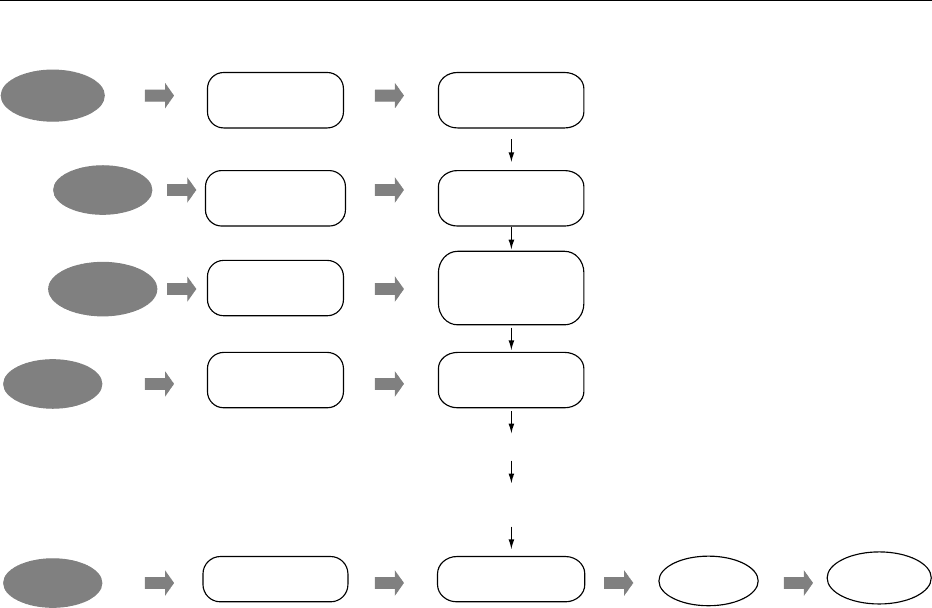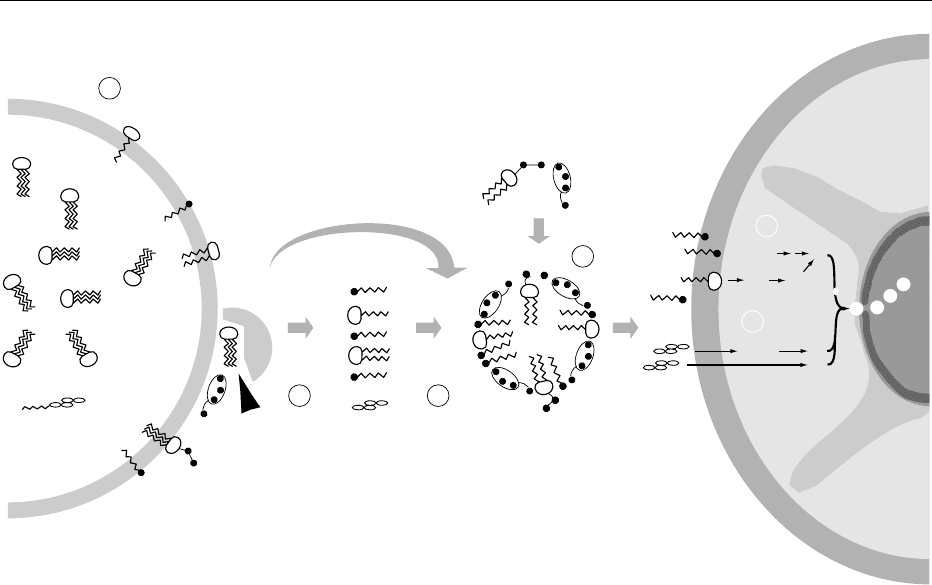Caballero B. (ed.) Encyclopaedia of Food Science, Food Technology and Nutrition. Ten-Volume Set
Подождите немного. Документ загружается.


of rye plus enzyme in the diets decreased endogenous
level of fat in the body composition of chickens com-
pared with a corn diet. The specific combination of
different energy sources in feed (tallow, soyabean oil,
rapeseed oil, fish oil) may influence the quality and
composition of endogenous fat in poultry. This cor-
relation between composition of feed fat and carcass
fat has been demonstrated in other studies. There was
a strong correlation between dietary fatty acid com-
position and tissue fatty acid composition for all fatty
acids except C14:0, C20:0, C20:2n-6, and C20:4n-6.
0036 Not only energy sources in feed but also protein
levels and sources have an effect on abdominal fat. In
one study, protein concentrates were used in different
combinations, compared with mixtures of a DKA-
grower diet containing 11% fishmeal and 35% of a
1:1 mixture of faba bean and full-fat rapeseed and a
DKA-grower diet containing 18% soyabean meal,
7% fishmeal, and 4% rapeseed oil. These nutrition
combinations influenced differentials in abdominal
fat composition: abdominal fat content was 12, 21,
and 40 g. Of total fatty acids in abdominal fat, 37.55,
33.96 and 30.43% was saturated, and 62.43, 65.74
and 69.39% was unsaturated. When used in the
feeding system in chickens, high-fat yeast (HFY;
Cryptococcus curvatus) reduced the proportion of
oleic acid in breast and thigh muscle in compare to
chicks fed mixtures with tallow or without fat sup-
plementation.
0037The main fat content in poultry is accumulated
under skin tissue. The content of fatty acids in this
tissue can be modified by different feed additives
(Table 9).
0038The influence of nutritional factors on laying hens,
performance and production is important. In repro-
duction eggs of laying hens, the lower content of
linoleic acid or linoleneic acid gives rise to decreased
hatchability, lower weight of embryos and chicks, and
slower rate of development during incubation. Chol-
esterol has an important function in this process, too.
Modification of consumption eggs is very popular,
especially as regards changes of fatty acids and vita-
min content. Changing eggs using the nutrition
system is called nutritionally enriched eggs (NEE)
(Table 10).
0039During feed modification of egg content, it is
important that the cholesterol level is 90% of that
required genetically.
0040In pork production the fatty composition of feed
grains has an important function. In pigs fed mixtures
with high levels of barley, the lard was white and
strong, compared with pigs fed mixtures principally
made up of corn, in which case the lard was yellow
and clammy.
0041There are three important principles in pig produc-
tion:
1.
0042Pigs fed a diet with a lower protein level cannot
produce a high level of protein in muscles (in rela-
tion to genetics);
2.
0043The highest level of protein in a low-energy diet
may increase fat synthesis;
3.
0044All organic components in a low-energy diet may
increase fat synthesis.
tbl0009 Table 9 Fatty acid composition in skin influenced fat
supplements
Specification of fatty supplements to mixture
Corn oil
6%
Tallow
6%
Corn oil 5%
andcod-liver
oil 1%
Ta llo w 5 %
and cod-liver
oil 1%
Fatty acids
Lauric (C12:0) 0.2 0.1 0.0 0.1
Myristic (C14:0) 0.8 2.9 0.8 3.4
Palmitic (C16:0) 16.1 23.4 15.9 23.3
Oleic (C18:1) 28.8 39.2 28.4 32.6
Linoleic (C18:2) 44.0 13.8 39.0 16.4
tbl0010 Table 10 Comparison of the contents of normal and modified eggs and feed additives which could change the fatty profiles in yolk
Feed additives Level of added
components
tomixtures
Nutrient content of NEE compared to ordinary egg: quantity/100 g egg content
Ordinary egg NEE
Fish oil 10–20 kg Total saturated fatty acids (g) 3.3 2.8
Full-fat ground linseed 100–150 kg Total unsaturated fatty acids (g) 6.4 6.9
Rapesced oil 5–10 kg MUFA (g) 4.4 4.4
BHT, BHA, etoxyquin 100–250 g PUFA (g) 1.2 2.2
Vitamin E 100–200 g Linoleic acid (g) (n-3) 1.0 1.3
Omega-6: omega-3 ratio 9.90 1.75
Unsaturated-to-saturated acids ratio 1.94 2.46
Cholesterol (mg) 400 350
NEE, nutritionally enriched eggs; BHT, butylated hydroxytoluene; BHA, butylated hydroxyanisole; MUFA, monounsaturated fatty acids; PUFA,
polyunsaturated fatty acids.
2268 FATS/Production of Animal Fats

Ruminants
0045 The possibility of modifying fat quality and content
in the body and milk of ruminants can be conducted
genetically and nutritionally. In genetic terms cross-
breeding special species of cattle with famous domes-
tic lines is a popular route. For example, the Japanese
meat-cattle Wagyu has a high intramuscular fat
content (shown by marbling of the meat) and a high
ratio of MUFA to SFA. A second example of genetic
modulation in fatty acid composition in beef is cross-
breeding between domestic cattle and bison in the
USA, creating a new species which was called beefalo.
Beefalo meat has less total fat, less saturated fat, less
cholesterol and fewer calories in comparison with
domestic breeds of cattle. In milk fat there are large
differences between species of cattle, for example,
Holstein cattle produce low fat milk (3.2–3.5%),
Ayrshire and Brown Swiss give 3.9–4.0% fat and
the highest content of fat is in milk produced by
Guernsey and Jersey cows (4.6%). Milk fat and
meat content can be modified by nutrition. Fattening
young cattle on grass fields (extensive model) has
decreased fat content in carcass in comparison with
the intensive model of feeding mixtures with grass
and high level of grains. Feeding milk-cattle a mixed
ration with lower effective fiber reduces the fat con-
tent in milk. Similarly, supplementing the diet with
trans fatty acids to inhibit milk fat synthesis decreased
milk fat level.
004 6 In ruminants improving the profile of fatty acids
in the feed does not directly improve the profile
of fatty acids in products, whether milk or meat.
In normal conditions cows only ingest 2.5–3%
of fatty acids in dry matter in their daily feed ration.
Fatty acids are delivered by triacylglycerides, galacto-
lipids, and phospholipids by ruminal microbial lipase
activity, and are modified to stearic acid. This form is
available in the intestine. Unsaturated fatty acids
from feed are biohydrogenated in the rumen to the
saturated acid form and fat in the ruminant’s body
(tallow) are highly saturated. The fat of ruminant
milk content compared to other fats has a high degree
of short-chain fatty acids. The precursors of fatty
acids in the rumen are carbohydrates which produce
volatile fatty acids: acetate, propionate, and butyrate.
Using a fresh grass feed in cows’ nutrition could
modify the content of healthy fatty acids in meat,
giving a decrease in SFA, increased intake of omega-
3 fatty acids and CLA. Studies have shown that the
ratio between omega-6 and omega-3 fatty acids is
decreased from 4:1 to 2.3:1 in the meat of cattle fed
grass. A similar effect is observed in milk cows fed
grass; the content of CLA was three or five times
higher then in ruminants fed grain diets. The final
way of modifying fatty acids in milk is to use pro-
tected fatty acids before rumen degradation.
Seealso: Eggs:DietaryImportance; Fats:Usesinthe
FoodIndustry;Digestion,Absorption,andTransport;
Requirements;FatReplacers;Classification;Occurrence;
Fatty Acids:Properties;Metabolism;Gamma-linolenic
Acid;Analysis;DietaryImportance;Trans-fattyAcids:
HealthEffects; Poultry:Chicken
Further Reading
Ba˛czkowska H and S
´
lo
´
sarz A (1987) Z
˙
ywienie Drobiu.
Warsaw: Pan
´
stwowe Wydawnictwo Rolnicze i Les
´
ne.
Banaszkiewicz T, Janocha A and Osek M (1995) Wplyw
mieszanek DKA z udzialem surowcow krajowych na
wyniki poubojowe kurczat brojlerow. Biuletyn Nau-
kowy Przemyslu Paszowego 34: 33–41.
Dhiman TR, Anand GR, Satter LD and Pariza MW (1999)
Conjugated linoleic acid content of milk from cows fed
different diets. Journal of Dairy Science 82: 2146–2156.
Dils RR (1983) Milk fat synthesis. In: Mephan TB (ed.)
Biochemistry of Lactation, pp. 141–157. Amsterdam:
Elsevier.
French P, Stanton C, Lawless F et al. (2000) Fatty acid
composition, including conjugated linoleic acid, of intra-
muscular fat from steers offered grazed grass, grass
silage or concentrate-based diets. Journal of Animal
Science 78(11): 2849–2855.
Grudniewska B (1994) Hodowla i uz
˙
ytkowanie s
´
win
´
. Olsz-
tyn: Wydawnictwo Akademii Rolniczo-Technicznej.
Horban
´
czuk O (2001) Nutritive value of ostrich meat.
World Poultry 17: 42–43.
Jackisch B and Jeroch H (1993) Results of further studies of
rye-containing feed mixtures with the enzyme prepar-
ation ‘‘Nutrizym-feed-additive’’ in broiler fattening.
Archives of Animal Nutrition 42: 55–61.
Jamroz D (ed.) (2001) Z
˙
ywienie Zwierza˛t i Paszoz-
nawstwo. Warsow: Wydawnictwo Naukowe PWN.
Kean MG and Allen P (1998) Effects of production system
intensity on performance, carcass composition and meat
quality of beef cattle. Livestock Production Science 56:
203–214.
Larbier M and Leclercq B (1995) Z
˙
ywienie Drobiu.
Warsaw: Pan
´
stwowe Wydawnictwo Naukowe PWN.
McDonald P, Edwards RA, Greenhalgh JFD and Morgan
CA (1995) Animal Nutrition, 5th edn. Edinburgh: Addi-
son Wesley Longman.
Miller GJ (1986) Lipids in wild ruminant animals and
steers. Journal of Food Quality 9: 331–343.
Minakowski W (1990) Biochemia kre˛gowco
´
w. Warsaw:
Pan
´
stwowe Wydawnictwo Naukowe.
Munro HN (1976) Fat content and composition of animal
product. National Academy of Sciences. /www.nap. edu/
openbook.
Narahari D (2001) Nutritionally enriched eggs. 2001.
Poultry International 40: 22–30.
FATS/Production of Animal Fats 2269

PalmquistDL,BeaulieuADand BarbanoDM(1993)Feed
andanimalfactorsinfluencingmilkfatcomposition.
Journal of Dairy Science 76:1753–1771.
ScaifeJR,MoyoJ,GalbraithH,MichieWandCampbellV
(1994)Effectofdifferentdietary supplementalfatsand
oils onthetissuefattyacid compositionandgrowthof
femalebroilers. British Poultry Science 35: 107–118.
SimopoulosAPandRobinsonJ(1999) The Omega Diet.
NewYork,NY:HarperPerrenial.
TrziszkaT(2001)Jajczarstwo.Wrocław:Wydawnictwo
AkademiiRolniczej.
WillhamRL (1976)Geneticsoffatcontentinanimal
products.NationalAcademyofSciences./www.na-
p.edu/openbook.
Uses in the Food Industry
L Boothby, Natland, Kendal, UK
Copyright 1993, Elsevier Science Ltd. All Rights Reserved.
Background
0001 The first oil and fat products to be used by humans,
apart from direct ingestion of vegetable oils from
plants, were from animal sources. As the world’s
meat industry developed, animal fats became useful
byproducts for baked goods. In the early 1900s, the
introduction of hydrogenation, or hardening, revolu-
tionized the usefulness of vegetable oils and enabled
the production of fats and blends, with a wide range
of physical properties overcoming some of the
limitations associated with animal fats. Today’s fat
technologists also modify fats by fractionation and
interesterification or a combination of two or more of
the above methods to give a wide selection of tailor-
made fats and blends. In more recent years, nutri-
tional considerations have increased the usage of
vegetable oils and fats. Similarly, the implication
that trans acids in the diet increase the risk of coron-
ary heart disease by raising low-density lipoprotein
(LDL) cholesterol and reducing high-density lipopro-
tein (HDL) cholesterol levels has led some manufac-
tures, particularly in yellow fats, to use blends with
no hydrogenated oils. Trans acids also occur in
animal and milk fats, albeit at lower levels than
hydrogenated vegetable oils. (See Vegetable Oils:
Dietary Importance.)
Functionality
0002 In addition to being an energy source and fulfilling
nutritional requirements, fats are necessary to carry
out one or more of the following functions in
various applications: (1) incorporate air; (2) provide
lubrication; (3) soften texture; (4) aid moisture reten-
tion; (5) as a heat exchange medium and flavor en-
hancer in fried goods.
Bakery Fats
Properties
0003General-purpose fats or shortenings must have the
following properties to perform satisfactorily in
cake-making:
1.
0004The shortening must be stable in the b-prime
polymorph.
2.
0005There must be a proportion of high melting tri-
glycerols present: 5% is normally sufficient.
3.
0006The ratio of solid to liquid triacylglycerols should
be such as to give a plastic solid over the normal
range of ambient temperatures.
4.
0007The oxidative stability must be sufficient to meet
product shelf-life requirements. (See Oxidation of
Food Components; Triglycerides: Structures and
Properties.)
Properties (1) and (2) are necessary to give a stable,
aerated batter and good texture in the baked product.
Property (3) is achieved by using a suitable blend of
component oils. The shortening must blend readily
with other ingredients during mixing. Plasticity also
depends on the temperature history of the fat. During
processing, rapid chilling is necessary to form a net-
work of inter-locking small crystals which enmesh the
liquid triacylglycerol phase. Slow chilling produces
large, irregular crystals, and in products such as
ghee a continuous liquid phase results. Storage tem-
perature and ambient temperature in the bakery also
affect plasticity. Property (4) is satisfied in most cases
by using unmodified liquid oils for the liquid phase. If
long-shelf-life products are required, oxidative stabil-
ity is increased by using lightly hydrogenated oils for
the liquid phase, e.g., soyabean oil with iodine value
reduced from 130 to 105, or rapeseed oil reduced to
iodine value 95 from 115. (See Ghee.)
0008General-purpose fats are suitable for pastry manu-
facture. b-Phase fats, notably lard, also produce ex-
cellent pastry products. Lard has a long plastic range
but produces cake batters of poor stability and result-
ant poor cake texture. Its use in shortenings is thus
limited to about 20% maximum. However, if costs
permit, changing the polymorph to b-prime by inter-
esterification significantly increases the inclusion
level to 60–70%.
Component Oils
0009The physical characteristics of some typical short-
eningcomponentsaregivenin Table 1.Mostfat
2270 FATS/Uses in the Food Industry

manufacturers have their own stock of standard
hydrogenated or fractionated oils. There is no justifi-
cation, for example, in a refiner carrying a range of
hydrogenated soyabean oils with melting points
ranging from 20
Cto50
C in steps of 5
C since
most user requirements can be met by blending a
limited number of hardstocks. All the figures quoted
for solid glyceride levels were determined by pulsed
nuclear magnetic resonance (pNMR) using Inter-
national Union of Pure and Applied Chemistry
(IUPAC) method 2.150. Tallow, hydrogenated marine
oils, hydrogenated cottonseed oil, hydrogenated palm
oil, and palm stearin are all b-prime fats used exten-
sively as hardstocks for shortening blends. (See Fish
Oils: Composition and Properties.)
Shortening Blends
0010 Typical shortening blends are given in Table 2, to-
gether with their pNMR profiles. Fat suppliers aim to
have a library of formulations which can be used to
give identical end products, so that least-cost options
are always available. Shortening blends without
middle melting triacylglycerols give satisfactory
baked goods but there can be some loss of eating
quality due to the increased level of high-melting
triacylglycerols. Advantages of this type of formula-
tion are an extended plastic range. Most manufac-
turers increase solid triacylglycerol levels by 2–4%
during summer months. Hydrogenated marine oil-
based shortenings possess excellent cake-making
properties but the increasing all-vegetable trend has
seen a decline in this type of shortening.
0011 High-ratio shortenings have similar blends to
the general-purpose fats, except for the addition of
2.8–3.2% a-monoacylglycerol, and in some cases a
similar level of diacylglycerols. High ratio refers to
the higher levels of liquor and sugar to flour that can
be used. Resultant cakes are moister, sweeter, and
resist staling longer than conventional cakes. Short-
enings with 1–2% monoacylglycerol are used to give
intermediate ratios of liquor and sugar.
0012Pourable or fluid shortenings are suspensions of
emulsifiers, sometimes with the addition of a small
level of high-melting b-phase fat, either in liquid
vegetable oil, or in a lightly hydrogenated vegetable
oil to give improved shelf-life.
0013Pumpable shortenings for large bakeries have
similar blends to conventional shortenings. They are
stored and delivered in jacketed tanks with
temperatures maintained between 24 and 28
C
depending on the blend. At the bakery the shortening
is delivered from controlled temperature storage by
positive displacement pumps and metered into
the mixer. (See Bread: Dough Mixing and Testing
Operations.)
Puff Pastry Fats
0014Puff pastry fats need to be tough and elastic to
achieve the multiple alternate layers of fat and
dough required to produce good lift. Puff pastry mar-
garines seem to be preferred to fats. To achieve the
necessary consistency, relatively high-solid glyceride
contents are used together with correct processing.
An excellent puff pastry fat can be produced from
lard containing 12–15% fully hydrogenated lard.
Tallow-based fats are also produced. Vegetable-
based fats utilize palm stearin and, hydrogenated
palm oil together with other hydrogenated vegetable
oils.
tbl0002Table 2 Typical general-purpose shortening blends and
pulsed nuclear magnetic resonance (pNMR) profiles
Component Not all
vegetable
fat (%)
All
vegetable
fat (%)
1212
Tallow 65
Hydrogenated fish oil (30
C) 80
Hydrogenated fish oil (49
C) 20
Palm oil 25 20
Hydrogenated palm oil (49
C) 5 10
Hydrogenated rapeseed oil (33
C) 40 25
Rapeseed oil 35 30
Hydrogenated rapeseed oil (20
C) 45
Percentage of solid triacylglycerols
(pNMR)
10
C 35454745
20
C 22272022
30
C 12101210
40
C 3 2 1 1.5
tbl0001 Table 1 Physical characteristics of some shortening
components
Fat Melting
point
a
(
C)
Percentage of solid
triacylglycerols at
different temperatures (
C)
Stable
polymorph
10 20 30 35 40
Butterfat 30 47 16 5 1 0 b-prime
Lard 36 49 26 8 5 2 b
Tallow 43 55 41 20 15 7 b-prime
Palm 37 50 22 11 5 2 b-prime
Palm (I) 42 52 35 15 9 6 b-prime
Palm (H) 49 95 92 80 63 42 b-prime
Palm stearin (F) 46 67 45 22 18 13 b-prime
Fish (H) 36 60 40 18 6 0.5 b-prime
Fish (H) 49 90 85 70 50 40 b-prime
Rapeseed (H) 33 75 50 15 4 0 b
a
BSI slip melting point (BS684, Part I, 1.3). I, interesterified;
H, hydrogenated; F, fractionated.
FATS/Uses in the Food Industry 2271

Biscuit Fats
Dough Fats
0015 Biscuit dough fats must be b-prime-stable to avoid
bloom development during the life of the biscuit.
However, certain different criteria are required com-
pared to shortenings:
1.
0016 The melting profile must be sharper for good
eating quality. There must be generally less than
5% solid triacylglycerols at 35
C and 0.5%
maximum at 40
C.
2.
0017 The oxidative stability needs to be high for a long-
shelf-life product, typically 40 h minimum at
100
C (measured by Rancimat instrument). Thus,
liquid oils are normally excluded from blends,
except for some specialized ‘health’ biscuits.
0018 Typical dough fat blends and pNMR profiles are
given in Table 3. Historically, the biscuit industry used
large quantities of hydrogenated marine oils. Palm or
hydrogenated palm oils are normally used to achieve
the b-prime polymorph in vegetable blends.
0019 Biscuit fats can be supplied ready for use in boxes.
The major producers receive blends in road tankers at
temperatures several degrees above the complete
melting point, store in suitable tanks, and subse-
quently chill and texturize as required.
Cream Fats
0020 Biscuit cream fats require medium to high solid tri-
acylglycerol levels at ambient temperatures, together
with a rapid melting profile, and, ideally, zero solid
triacylglycerols at body temperature. On high-speed
production lines the fat must set quickly and give
good coherence to the biscuit. Biscuit creams are
basically mixtures of icing sugar and fat with or with-
out added colors and flavors. Typical cream fats and
their melting profiles are given in Table 4.
0021The lauric oils – coconut and palm kernel – are
ideal starting materials. In addition to rapid melting
they are very bland and can be refined to very low
color levels. Hydrogenated rapeseed and soyabean
oils with high trans acid levels can be used singly or
in combination with lauric fats. In these blends low-
melting saturated acids are partially replaced by trans
acids – mainly elaidic acid, which has a similar
melting point to lauric acid (42
C).
Low
Trans
Acids Blends
0022Suitable low trans acids blends can be formulated
using fractionated or interesterified oils. Examples
are given in Table 5 for different applications. To
achieve zero to trace levels of trans acids it is neces-
sary to use deodorization temperature below 235
C,
particularly if liquid oils are included in the blend;
this precludes the use of physically refined oils.
Frying Oils
0023Frying oils need to be as stable as possible under the
harsh conditions used. This is achieved by using
oils with the lowest possible level of unsaturation
concomitant with good eating quality and very low
trace-metal levels. Thus, hydrogenated oils should be
posttreated to remove traces of catalyst completely.
Stability is also important to achieve a reasonable
shelf-life, particularly in potato crisps and snack
foods, with their large surface area to weight ratios,
and oil contents up to 40%.
0024Oils are delivered in bulk to the snack-food indus-
try. Suitable oils are lightly hydrogenated soya bean
or rapeseed, with linolenic acid levels reduced below
3%, palm olein, and blends of palm oil with vegetable
oils. Sunflower is used successfully to produce health-
branded products. Frozen chip producers require
harder oils to avoid problems during blast-freezing.
Suitable oils are palm or hydrogenated palm oil.
tbl0003 Table 3 Examples of biscuit dough fat blends and pulsed
nuclear magnetic resonance (pNMR) profiles
Animal/vegetable Fat (%) All vegetable Fat (%)
Hydrogenated fish
oil (32
C)
55 Hydrogenated soya
oil (35
C)
50
Palm oil 35 Palm olein 10
Hydrogenated palm
oil (42
C)
10 Palm oil 40
Percentage of solid
triacylglycerols (pNMR)
20
C25 28
30
C8 10
35
C2.5 4
40
C 0 0.5
tbl0004Table 4 Examples of biscuit cream fats and melting profiles
Fat
(%)
Fat
(%)
Fat
(%)
Coconut oil 65
Hydrogenated palm kernel oil (34
C) 15 100
Hydrogenated palm oil (42
C) 20
Hydrogenated soyabean oil (34
C) 100
Percentage of solid triacylglycerols (pNMR)
20
C417460
30
C4.51420
35
C223
40
C000
pNMR, pulsed nuclear magnetic resonance.
2272 FATS/Uses in the Food Industry

These products contain 2–5% oil, which is diluted by
the end users’ frying media.
0025 The catering industry uses palm oil, beef-tallow
liquid vegetable oils, and long-life frying oils based
on lightly hydrogenated vegetable oils. The latter nor-
mally contain a low level of a b-phase fat such as fully
hydrogenated rapeseed oil. Chilling and texturizing
produce a stable pourable frying oil. An antifoaming
agent (methyl polysiloxane) is generally added to
long-life frying oils. Antioxidants are not normally
added; they give protection prior to use but there is
little carry-through to the finished product. Residual
tocopherols in vegetable oils give some benefit. (See
Antioxidants: Synthetic Antioxidants; Tocopherols:
Properties and Determination.)
Processing
Shortenings
0026 Fats and blends are stored above their complete
melting points immediately prior to processing. The
first stage is normally a water precooler to reduce
variations in feed temperature to the main chilling
unit. The main chilling unit is a continuously scraped
surface heat exchanger, comprising a cylinder with
refrigerant on the outside, and inside a rotating shaft
with floating scraper blades. The molten fat is pumped
under high pressure through the annular space whilst
the scraper blades remove chilled fat from the cylin-
der wall. This step initiates the crystallization before
passing to the second unit, sometimes referred to as a
‘B’ unit or ‘puddler’ or ‘worker.’ In the ‘B’ unit the fat
completes most of its crystallization whilst being agi-
tated by a combination of paddles and baffles; most
of the heat of crystallization is dissipated.
0027 Absence of a ‘B’ unit results in nonplastic
shortening. Processing plants normally consist of
several chilling and ‘B’ units linked in series. The
final stage involves further mechanical working by
passing the shortening through an extrusion or tex-
turizing valve immediately prior to filling the con-
tainer – normally polythene-lined boxes. The whole
system generally operates at pressures between 2 and
3 MPa. Depending on the blend, chilling tempera-
tures can vary between 16
C and 22
C and filling
temperatures between 19
C and 25
C.
0028The final stage after filling is ‘tempering’ or
‘annealing’. Containers are stored in a temperature-
controlled environment between 24
Cand28
C for
at least 48 h. This step allows the shortening to stabil-
ize in the b-prime polymorph and extends the plastic
range, so enabling the shortening to be used over a
wider temperature range without loss of performance.
0029Most shortenings have air or, preferably, nitrogen
introduced prior to chilling to give a white appear-
ance; the normal level varies between 8% and 15%
by volume. The level of gas does not influence final
performance and is introduced for cosmetic reasons.
Shortenings without gas perform equally well but
have a pale yellow, petroleum jelly-like appearance.
Colors, such as b-carotene and vitamins, can be
added if required. Colored shortenings do not nor-
mally include nitrogen.
0030Pumpable shortenings are processed similarly but
after texturizing are stored in special temperature-
controlled tanks at tempering temperatures. Further
work softening occurs when the shortening is pumped
into and out of the delivery vehicle, and again just
prior to mixing by the end user. Omission of nitrogen
from pumpable shortenings gives more accurate
metering into the mixer.
Puff Pastry Fats
0031Puff pastry fats can be chilled in a similar manner to
shortenings or on open chilling drums with a scraper
tbl0005 Table 5 Low trans acids blends and pulsed nuclear magnetic resonance (pNMR) profiles
Component oils General shortening Biscuit dough Biscuit cream
12 1212
Palm stearin/coconut 80:20 (I) 15
Palm (I) 40 85
Palm 20
Rapeseed oil 25
Palm/rapeseed oil 83:17 (I) 100
Palm/coconut oil 70:30 (I) 100
Palm kernel oil 15
Palm kernel stearin (F) 100
Fully hydrogenated palm/palm kernel 30:70 (I) 100
Percentage of solid triacylglycerols (pNMR)
20
C242329277057
30
C 10 10 8.5 11 8 21
35
C352504
40
C11010
FATS/Uses in the Food Industry 2273

blade running the length of drum and refrigerant on
the inside. Moisture condensation can give problems
in the latter process. After chilling, the fat is allowed
to crystallize slowly in long resting tubes or in skips.
The fat is then plasticized before extruding into
blocks. The drum method gives fats of excellent plas-
ticity. No tempering is necessary but low storage
temperatures should be avoided.
Other Fats
0032 Confectionery, toffee, icecream, cream, and frying
fats are chilled, texturized, and packed as shorten-
ings, but without tempering. (See Ice cream: Methods
of Manufacture.)
See also: Antioxidants: Synthetic Antioxidants; Bread:
Dough Fermentation; Fish Oils: Composition and
Properties; Ghee; Ice Cream: Methods of Manufacture;
Oxidation of Food Components; Tocopherols:
Properties and Determination; Triglycerides: Structures
and Properties; Vegetable Oils: Types and Properties; Oil
Production and Processing; Dietary Importance
Further Reading
Bailey AE (1985) In: Applewhite TH (ed.) Industrial Oil and
Fat Products, 4th edn, vol. 3. New York: John Wiley.
Baldwin RR, Baldry RP and Johansen RG (1972) Fat
systems for bakery products. Journal of the American
Oil Chemists Society 49: 473–477.
Hoerr CW (1960) Morphology of fats, oils and shortenings.
Journal of the American Oil Chemists Society 37: 539–
546.
Knightly WH (1981) Shortening systems: fats, oils and
surface-active agents – present and future. Cereal
Chemistry 58: 171–174.
Lefebvre J (1983) Finished product formulation. Journal of
the American Oil Chemists Society 60: 295–300.
Vaisey-Genser M and Ylimaki G (1989) Baking with canola
oil products. Cereal Foods World 34: 246–258.
Digestion, Absorption, and
Transport
T H M Da Costa, Universidade de Brası
´
lia, Brası
´
lia,
DF, Brazil
Copyright 2003, Elsevier Science Ltd. All Rights Reserved.
Background
0001 Fats or lipids are the concentrated form of energy in
the diet, providing 9 kcal g
1
(37 kJ g
1
), and have
evolved as the most advantageous form of energy
storage, owing to their hydrophobic characteristics.
Triacylglycerols are the most common of the lipids
either in the diet or as lipid tissue stores. They are
formed by the esterification of glycerol and fatty acids
(1:3 molar ratio). Triacylglycerols vary depending on
the three fatty acid residues they contain; simple tria-
cylglycerols contain a single type of fatty acid residue.
For example, trioleoylglycerol or triolein (a simple
triacylglycerol) has three oleic acid residues, and
mixed triacylglycerols contain two or three different
types of fatty acid residues. The fatty acid moiety
varies greatly in nature, and the ingestion of triacyl-
glycerols containing saturated or unsaturated, long-
and/or short-chain fatty acids depends on the source
of lipids in the diet.
0002Fat is an important food energy source in the West-
ern world, ranging from 30 to 40% of daily energy
intake, equivalent to the daily consumption of
50–120 g in an adult. Other lipids play less important
roles as energy sources under normal physiological
circumstances, but serve as structural components
of cell membranes, metabolic cofactors and as
hormones (phospholipids, sphingolipids, cholesterol,
diacylglycerol, and steroids). The diet constitutes the
major source of lipids for the body and supplies
essential fatty acids and lipid-soluble vitamins that
cannot be synthesized endogenously. Lipogenesis,
de novo synthesis of triacylglycerols from carbo-
hydrate, occurs when there is a high ingestion of the
latter.
0003The first part of this chapter reviews present knowl-
edge on the mechanisms of digestion and absorption
of dietary lipids, mainly triacylglycerols, and the
second part deals with the complex transport system
of lipids in the circulation.
Lipid Digestion and Absorption
0004Owing to their hydrophobic characteristics, lipids are
digested by a dynamic and complex mechanism that
facilitates their solubilization and hence availability
for enzymatic action. The process can be divided into
four main phases: emulsification, hydrolysis of fatty
acid ester bonds by lipases, aqueous dispersion of
lipolytic products in bile acid micelles, and uptake
by the enterocytes (Figure 1).
0005In the process of fat digestion, there is a minor
contribution of lingual lipase, which hydrolyzes
some long-chain fatty acid triacylglycerols, and
gastric lipase, which contributes to the hydrolysis of
short- or medium-chain fatty acid triacylglycerols.
The main process of lipid digestion takes place in
the small intestine. In the duodenum, triacylglycerols
aggregate in droplets and are emulsified by the action
of the bile salts, monoacylglycerols (originating from
intragastric lipolysis), and lysolecithin. The fat
2274 FATS/Digestion, Absorption, and Transport

droplets are attacked by the colipase and pancreatic
lipase complex. Colipase, a pancreatic protein that
protects the lipase from denaturation and anchors it
to the lipid–water interphase of the droplet, permits
access of the lipase to the inner core of triacylglycer-
ols. In fact, when the lipase binds to the interphase of
the lipid droplet, the catalytic rate of the enzyme is
increased (surface activation). Pancreatic lipase
hydrolyzes ester links in the 1–3 positions of the
triacylglycerols releasing fatty acids and 2-monoacyl-
glycerol (Figure 2).
0006 Phospholipids from the diet or secreted in the bile
(lecithin) are attacked by pancreatic phospholipase
A
2
, which cleaves the fatty acid at the 2 position,
forming lysophospholipids and lysolecithin, respect-
ively. Lysolecithin aids in the emulsification process.
Cholesteryl esters, the main form of cholesterol in the
diet, are hydrolyzed to free cholesterol by a pancre-
atic enzyme cholesterol esterase and aggregate into
micelles. Cholesterol esterase also hydrolases retinyl
esters. Its action increases the polarity of cholesteryl
and retinyl esters, which are highly hydrophobic mol-
ecules, allowing their micellar solubilization. Free
cholesterol derived from biliary secretion and cell
decay is also incorporated into micelles. When the
proportion of bile acids and phospholipids reaches a
critical micellar concentration, micelles are formed
and take up free fatty acids and monoacylglycerols,
and the expanded micelle is water-soluble.
0007In the aqueous interface between the micelles and
the epithelial cell surface, known as unstirred water
layer, the micelles dissociate, and the concentration of
fatty acids, monoacylglycerols, and lysophosphogly-
cerols increases, and these diffuse freely through the
apical enterocyte membrane. Saturated fatty acids
with a carbon length of 18 are poorly absorbed in
the free state but well absorbed as 2-monoacylglycer-
ols. Very-long-chain fatty acids with high melting
points are less efficiently absorbed. Triacylglycerols
and diacylglycerols, which are not acted upon by the
lipase, do not dissolve well in bile salts and remain in
lipid droplets. Unabsorbed fat in feces is usually
below 5%. Bile salts that are separated from the
micelles remain in the intestinal lumen and are
absorbed in the distal ileum by an active transport
system or are lost in the feces.
0008Short-chain (C:2–C:4) and medium-chain-length
(C:6–C:14) fatty acids are more hydrophilic and are
rapidly absorbed independent of micellar solubiliza-
tion or re-esterification within the intestinal cells.
They are transported via the portal circulation dir-
ectly to the liver. In the newborn, about half of the
Mouth
Stomach
Organs
Process
Emulsification
TG, FA, MG
Hydrolysis
FA, MG
Solubilization
Micelles
BA, PL, MG, FA
Uptake
Esterification
Chylomicrons
Synthesis
re-esterification of TG + apo B
48
Pancreas
Gall-bladder
Intestine
Linfatic
Vessels
Lingual lipase
Gastric lipase
Pancreatic lipase
Colipase
Bile acids
Enterocyte
Lymph Chylomicros
Blood
Peripheral
Tissues
fig0001 Figure 1 Process of triacylglycerol digestion and absorption showing the organs, enzymes, and processes involved. TG, triacyl-
glycerols; FA, fatty acids; MG, monoacylglycerol; BA, bile acids; PL, phospholipids.
FATS/Digestion, Absorption, and Transport 2275

medium-chain fatty acids from milk can be absorbed
in the stomach. In the enterocyte membrane, a fatty
acid-binding protein (FABP) facilitates the transport
of long-chain fatty acids (carbon chain length > 12)
into the cytosol and reduces the potential cytotoxic
effect of fatty acid soaps. Cholesterol binds to a sterol
carrier protein as it enters the cell. In the enterocyte,
cholesterol is re-esterified with a fatty acid by the
action of the enzyme acyl-CoA:cholesterol acyltrans-
ferase (ACAT). The fatty acids and monoacylglycer-
ols are re-esterified to triacylglycerols within the
endoplasmatic reticulum of the enterocyte, and then
are combined with phospholipids, cholesterol, cho-
lesteryl esters, and apolipoproteins, forming chylomi-
crons. Apo-B
48
is the structural protein of
chylomicrons. The process of chylomicron assembly
takes place in the Golgi apparatus, and the movement
of triacylglycerides from the endoplasmatic reticulum
to the Golgi appears to be a rate-limiting step in the
process. The union of triacylglycerol to apo-B
48
re-
quires a microsomal triacylglyceride transfer protein
(MTP). Finally, chylomicrons are released by exocy-
tosis to the lymphatic system and enter the blood
circulation by the left subclavian vein (Figure 2).
Lipid Transport in the Plasma
0009Lipids are transported in the hydrophilic blood
plasma environment as lipoproteins. Lipoprotein
particles consist of a core of triacylglycerol and chol-
esteryl esters, in varying proportions, surrounded by a
more hydrophilic layer of phospholipids, unesterified
cholesterol, and protein. In the circulation or as
a constitutive component, each lipoprotein particle
1
2
Mixed micelle
Bile
PL
FA FA + CoA
MG
MG
DG
ACAT
TG
MTP
CM
CE
C + FA
C
Lymph
ApoB
48
BA
3
4
5
6
TG
CE
FAT
DROPLET
INTESTINAL LUMEN
INTESTINAL
CELL
FA
MG
DG
C
fig0002 Figure 2 Diagrammatic representation of triacylglycerol and cholesterol digestion and absorption in the gastrointestinal tract. A fat
droplet is shown (1) with insoluble triacylglycerols (TG) and cholesteryl ester (CE) in the core. The products of early lipolysis by lingual
and gastric lipases: fatty acids (FA), diacylglycerol (DG) and monoacylglycerol (MG) and also dietary phospholipids with their polar
heads face the outside of the droplet. Pancreatic lipase (2) acts at the water–oil interphase hydrolyzing TG molecules, with the
participation of bile acids (BA) and colipase, which anchors the lipase to its catalytic site. Cholesterol esterase acts on cholesteryl
ester forming free cholesterol (C). Lipolytic products (3) interact with bile acids (BA) and phospholipids (PL), facilitating their
solubilization into micelles (4). In the unstirred water layer, micelles dissociate, and their content diffuses to the enterocyte. Inside
the intestinal cell, fatty acids (FA) are activated and are re-esterified to TG (5). Cholesterol is absorbed and re-esterified with a fatty
acid by the action of the enzyme acylCoA:cholesterol acyltransferase (ACAT) originating cholesteryl ester (CE) (6). Chylomicron (CM)
synthesis requires the enzyme microsomal triacylglycerol transfer protein (MTP) to assemble the structural protein apo-B
48
to
triacylglycerols. Mature chylomicrons also incorporate cholesteryl esters to the core, and phospholipids, free cholesterol and
apoplipoproteins to the surface. Chylomicrons exit the enterocytes by exocytosis to the lymph. Adapted with permission from Ros E
(2000) Intestinal absorption of triglyceride and cholestrol. Dietary and pharmacological inhibition to reduce cardiovascular risk. Ath-
erosclerosis 151: 357–379.
2276 FATS/Digestion, Absorption, and Transport

contains specific proteins, termed apolipoproteins
(Figure 3).
0010 There are at least 12 apolipoproteins described and
present in different proportions among the lipopro-
teins (apo-AI, II and IV, Apo-B
48
and B
100
, apo-CI, II
and III, apo-D and apo-EII, III and IV). The apolipo-
proteins, apart from giving stability to the lipoprotein
particle, also direct the lipoprotein to its site of
metabolism by interactions with specific enzymes
and transport proteins on cell membranes. The ratio
of lipid to protein, which determines the density of
lipoproteins, is important in the classification of the
five major lipoproteins: chylomicrons; VLDL, very-
low-density lipoprotein; IDL, intermediate-density
lipoprotein; LDL, low-density lipoprotein; and HDL,
high-density lipoprotein. As the lipoproteins are
delipidated, the diameter reduces, and the density
increases. The lipoproteins exist in a dynamic state,
and their separation into one of the above classes,
according to their flotation characteristics, refers to
average values. Chylomicrons, the least dense of
all lipoproteins, have the highest proportion of tria-
cylglycerols (85–90%) and transport mainly lipids
from exogenous (dietary) origin. As already men-
tioned, during their assembly in the enterocytes,
they acquire apo-B
48
. Nascent chylomycrons also
contain apo A-I, apo A-IV, and, to a lesser extent,
apo A-II. Apo A-I and apo A-II enter the circulation in
chylomicrons but are rapidly transferred to nascent
HDL (Figure 3). Apo A-IV secreted by the enterocytes
is likely to mediate the anorectic effect of a lipid meal.
It is proposed that apo A-IV acts as endogenous anti-
oxidant and is involved in fat absorption.
0011VLDL, IDL, and LDL are related particles that
transport endogenous (synthesized in the liver) tri-
acylglycerols and cholesterols to peripheral tissues.
Intestine
Nascent
chylomicrons
(Apo B
48
Al, AlV)
Liver
VLDL
Remnants
VLDL
(APoE,CII, B
100
)
IDL
(APoE, B
100
)
LDL
(APo B
100
)
Small dense
LDL
Circulating
chylomicrons
(Apo E, CII, ApoB
48
)
ApoAl
Bile acids
+ cholesterol
LPL
LPL
NEFA
ApoE
ApoE
ApoB
Hepatic
receptors
LPL
FA
FA
CETP
CE
LCAT
CELL
Cholesterol
LCAT
HDL
2
HDL
2
HDL
3
TG
HL
HL
LPL
TG
CETP
CE
Chylomicrons
remnants
HDL Nascent
Apo Al e All
Adipose tissue
Muscle
fig0003 Figure 3 Scheme for the transport of triacylglycerol and cholesterol in plasma. The classes of lipoproteins are shown: chylomicrons
and chylomicrons remnants; VLDL, very-low-density lipoprotein; IDL, intermediate-density lipoprotein; LDL, low-density lipoprotein;
HDL, high-density lipoprotein, with its subclasses: nascent-HDL, HDL
2
, and HDL
3
. The major apolipoproteins associated with each
lipoprotein are presented in parenthesis. Enzymes involved in the process of lipoprotein metabolism: LPL, lipoprotein lipase; HL,
hepatic lipase. Enzymes related to lipoprotein lipid exchange: LCAT, lecithin:cholesterol acyltransferase; CETP, cholesterol:ester
transfer protein. Hepatic receptors are indicated with their ligand for binding to cell-surface Apo-E or Apo-B. For more details, refer to
the text. Adapted with permission from Packard and Shepherd (1996).
FATS/Digestion, Absorption, and Transport 2277
